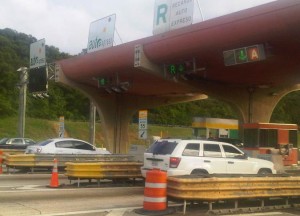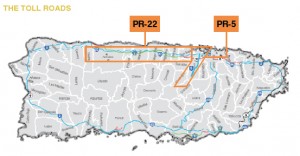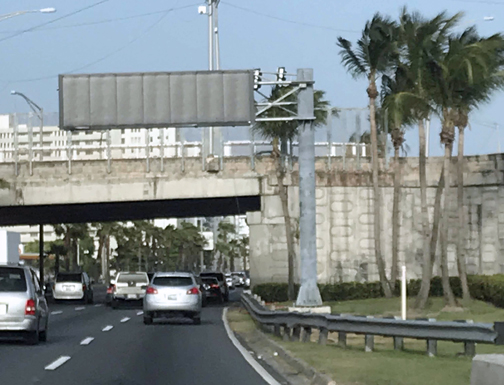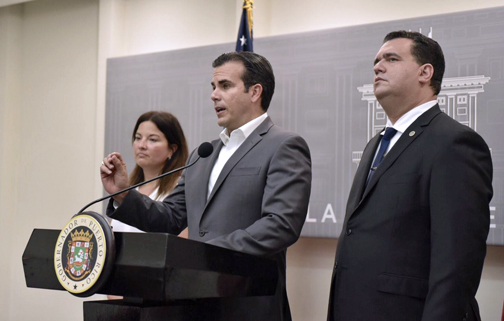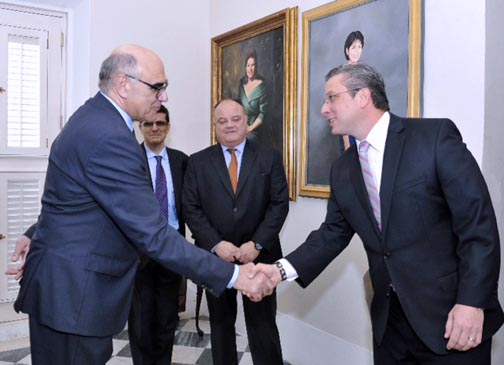Highway PPP to be announced June 20

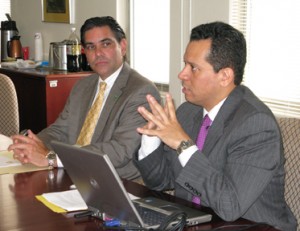
P.R. Highway Authority Executive Director Rubén Hernández Gregorat and P3 Authority Executive Director David Álvarez.
Following a lengthy evaluation process, the government will announce Monday the winner of the concession to manage one of the island’s principal highways, and a secondary road, Puerto Rico Public-Private Partnerships Authority Executive Director David Álvarez told a small group of journalists Thursday.
While he refrained from disclosing how much the management contract will be worth, along with other financial details of the transaction, Álvarez stressed that the PPP — the first highway concession to be granted in the U.S. since 2006 and the first PPP of the year — will achieve the goals of attaining “world-class infrastructure, investment for economic development and propping up the Puerto Rico Highways and Transportation Authority’s finances to enable other projects.”
As News is my Business reported in late May, the competition is down to two consortia: Goldman Sachs Infrastructure Partners II, L.P. and Abertis Infraestructuras, and Morgan Stanley Infrastructure Inc. and OHL Concesiones. Industry reports put the 40 to 50-year contract at about $1 billion. A total of eight groups showed interest in the contract, but half were disqualified and only two submitted proposals, Álvarez said.
“This is not a small-scale project, it’s not only important on the local level, but on a national level as well,” said Álvarez, who was joined by PRHTA Executive Director Rubén Hernández-Gregorat. “By having completed the process in Puerto Rico, we’re already winning because of the caliber of consortia that have participated.”
In his presentation to the media, Álvarez noted, among other things, that the chosen private operator will be required to pay the government a yet-undisclosed sum up-front, and make subsequent payments.
Up for private management are PR-22, a 52-mile stretch of highway that runs from the entrance of the Minillas Tunnel in Santurce to the western town of Hatillo, and PR-5, a 2.5-mile road that begins at the intersection with PR-2 in Bayamón through PR-199.
Both are toll roads, generating $85.1 million and about $4 million in annual revenue, respectively. The combined toll collections represent about 50 percent of the PRHTA’s annual revenue, according to a document posted on the P3 Authority’s website.
Upon signing the contract, the winning consortium must make significant investments to rehabilitate the toll roads turn them into world-class level highways with respect to paving, signage, lighting, vehicle flow, safety, and service and toll plazas, among others, the P3 Authority said. The first projects should start within three months of signing, and be completed in a year.
Earlier this month, P3 Authority board member Hernán Padilla noted the chosen group must invest $90 million in the first five years of the contract on “specific and substantial” improvements, and another $312 million to “design, fix and implement changes to meet operating standards that raise the quality of the PRHTA to a world-class level.”
“Puerto Rico sees investment immediately,” said Álvarez during his meeting with the media.
Staggering debt
On Thursday, Álvarez said by turning over the roads’ management to a financially capable private operation, the PRHTA will be able to address its staggering debt, currently pegged at more than $6.2 billion. The agency, he said, has had to turn to the Government Development Bank for credit to cover its cash flow needs.
Since details on the proposed PPP’s financial terms have not been revealed, remains unclear Monday how the agency will reconcile its debt and repay the $1.2 billion credit line plus $80 million in accrued interest it owes the GDB.
As a result of its dire fiscal situation, the PRHTA has significantly cut back on its investments, at a rate of about 15 percent a year. In fiscal 2010, the agency invested $126 million in road improvements, in comparison to the $188 million the prior year, the P3 Authority said.
“PR-22 suffers from dilapidated infrastructure that is evident in its safety elements, pavement and signage that is more noticeable during daily vehicular congestion,” Álvarez said.
Some 200,000 vehicles travel on PR-22 on a daily basis, Hernández Gregorat said. During peak hours, when traffic is at its heaviest, the average speed on that road is eight miles per hour, he said.
“A highway is designed to offer the service of speed and shorten the time spent in transportation,” Hernández Gregorat said. “During peak hours, drivers neither enjoy that speed guarantee nor service that they pay for through the toll.”
Uncertain road ahead
Given that the PRHTA will be turning over the toll plazas that generate half of its annual revenue through the proposed PPP, it is unclear how the agency will improve its bottom line once the transaction is signed.
In a column published in a local newspaper earlier this month, Padilla said “it is crucial that the contract ensures that, aside from having no toll increases until 2014, any future increases must be predetermined, known and reasonable.”
Future toll increases cannot exceed the current inflation rate, Álvarez said Thursday.
“The Teodoro Moscoso bridge toll plaza has been managed under that same concept and the increases have been significant,” said a source familiar with PPP transactions in general, who spoke to News is my Business on the condition of anonymity.
Furthermore, the source questioned the true benefits of turning over the operation of the island’s main toll roads to private hands, saying the operator will likely generate the same revenue the government would.
“There aren’t great efficiencies to achieve neither in the maintenance nor operation of the toll road, so where is the monetization coming from?” the source said. “The Highway Authority is already automating the toll plazas, so they will obtain benefits from that regardless.”
The volume of vehicles will not likely increase because there is improved lighting or better road conditions, the source said, so any revenue increase will stem from a future toll increase. Furthermore, during the news conference, the government officials confirmed that the private operator will not be allowed to build new toll plazas along the stretch of highways.


